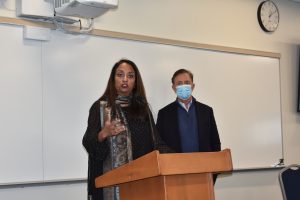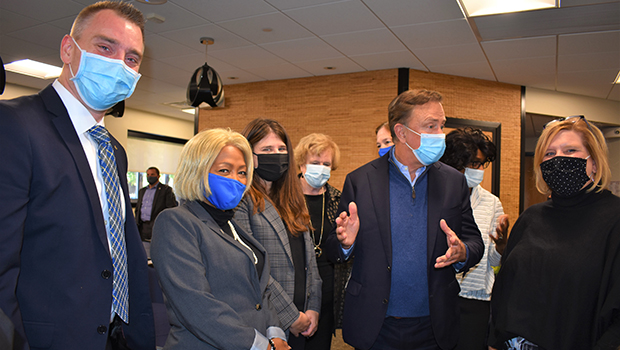With COVID vaccines now available to nearly all public school students, Connecticut has unveiled a new initiative—Screen and Stay—that allows schools to reduce the number of repeated quarantines that disrupted much of the previous school year.
While the state rolls out vaccines to children ages 5-11, Screen and Stay allows students and staff identified as close contacts to a known COVID-19 case to remain in school, even if they are unvaccinated, as long as they complete and submit a screening form to school each day for 10 calendar days indicating that they are symptom-free. With 26,000 students having experienced at least one remote day in the month of September, the program provides relief from the frequent quarantines that impacted student learning and placed a burden on working families.
Screen and Stay is effective immediately, and schools’ participation is voluntary. Read more about the specifics of the initiative here.
Collaborating for a better school experience
Announced at a news conference livestreamed today from Newington High School, the initiative was introduced by Governor Ned Lamont, Public Health Commissioner Manisha Juthani, and Education Commissioner Charlene Russell-Tucker, with resounding support and input from CEA, AFT Connecticut, the Connecticut Association of Boards of Education, the Connecticut Association of Public School Superintendents, and other education and community stakeholders.
CEA President Kate Dias praised the initiative and the individuals and groups—including CEA and AFT—that collaborated on it, saying, they “really put forward a plan that meets our genuine priority of having everyone in school.” Expressing gratitude to the governor and the program’s fellow partners, she said, “Our ability to modify, adjust, and reflect on our practices is what makes Connecticut special, and it’s what will continue to make us a leader in pandemic practices.”

Public Health Commissioner Manisha Juthani says in-person learning “is exquisitely important” to students’ social, emotional, and behavioral health.
Calling Screen and Stay a game-changer in terms of reducing the need to quarantine, DPH Commissioner Manisha Juthani spoke of the social, emotional, and behavioral health benefits of in-person learning.
“Being in the classroom is exquisitely important to remain on track,” she said.
Access to in-person learning is a priority, SDE’s Russell-Tucker added, because students learn best in person and have access to critical services that their schools provide. She thanked teachers’ unions for collaborating on the plan and said, “Our state models so well putting our educators and students at the center of everything we do.”
Newington Public Schools Superintendent Maureen Brummett also acknowledged the influence and input of teachers’ unions, saying, “We are a CEA school.”
Stronger together
Speaking to officials and the media, and directly addressing the 23 members of Newington High School’s student leadership council who attended the news conference, CEA’s Dias—a high school math teacher—reflected, “I taught during the pandemic and dealt with the disrupted learning, like all of our students in the room. I knew what it was like to have students in quarantine coming in and out of school and how challenging it was for both educators and the students. The level of disruption that this allows us to move away from and really incorporate daily education regularly, predictably, and consistently is invaluable in ways that are hard to quantify. It really means so much to educators and their students. What we want most of all is to be present. What we want most of all is to interact. And what we want most of all as the adults is to teach. We want to be with you. I teach statistics, and so that was my joy—we want to learn with you. Teaching is messy. And it was so hard to do online. Learning is messy, and it’s so hard to do online. But we can navigate those messy roads together in a space, and this allows us to do that. I thank you kids for hanging in there with us, because it’s been rough, and we are excited to be with you as much as possible. And thank you, educators—stay strong.”

CEA President Kate Dias emphasizes that safe, in-person learning is a win-win for students, educators, parents, and communities.
Programs similar to Connecticut’s Screen and Stay have successfully been rolled out in North Carolina and elsewhere.
What about masks?
Asked about when the mask mandate in schools might be lifted, both the governor and health commissioner called Screen and Stay a first step in the off-ramp from the pandemic, explaining that benchmarks such as vaccination rates for children 5-11 would need to be monitored and low community spread maintained. The governor also cautioned that with holiday gatherings and travel around the corner, any reassessment of the mask mandate would have to take place in December or January.
Local legislators were on hand to offer their support for Screen and Stay and to thank educators for making safe learning a priority throughout the pandemic.
“My gratitude to the students, parents, teachers, paras all going through this for the past two years,” said Senator Matt Lesser.
“Everything teachers and other community leaders have been doing is all about trying to keep you safe and have the best education possible,” Representative Gary Turco added.







